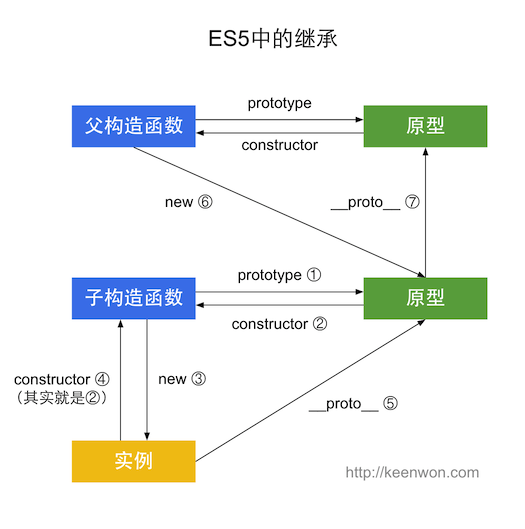js的继承方式可谓是五花八门啊,而且我用的频率也不高,因此很容易遗忘,很容易搞混。所以就来总结一下。
先来看一张图:
可以看到js的构造函数、原型、实例之间的关系。
接下来总结下js所有的继承方式:
原型链
function SuperType(){
this.property = true;
}
SuperType.prototype.getSuperValue = function(){
return this.property;
};
function SubType(){
this.subproperty = false;
}
//继承了 SuperType
SubType.prototype = new SuperType();
SubType.prototype.getSubValue = function (){
return this.subproperty;
};
var instance = new SubType();
alert(instance.getSuperValue()); //true
这里的SubType通过prototype继承了SuperType,因此具有了父级也就是SuperType的getSuperValue方法和property属性。
当然,这个继承方法有很多的注意点,比如:
新加方法和重写方法:
//添加新方法
SubType.prototype.getSubValue = function (){
return this.subproperty;
};
//重写超类型中的方法
SubType.prototype.getSuperValue = function (){
return false;
};在通过原型链实现继承时,不能使用对象字面量创建原型方法。因为这
样做就会重写原型链,如下面的例子所示。
function SuperType(){
this.property = true;
}
SuperType.prototype.getSuperValue = function(){
return this.property;
};
function SubType(){
this.subproperty = false;
}
//继承了 SuperType
SubType.prototype = new SuperType();
//使用字面量添加新方法,会导致上一行代码无效
SubType.prototype = {
getSubValue : function (){
return this.subproperty;
},
someOtherMethod : function (){
return false;
}
};
var instance = new SubType();
alert(instance.getSuperValue()); //error!借用构造函数
function SuperType(){
this.colors = ["red", "blue", "green"];
}
function SubType(){
//继承了 SuperType
SuperType.call(this);
}
var instance1 = new SubType();
instance1.colors.push("black");
alert(instance1.colors); //"red,blue,green,black"
var instance2 = new SubType();
alert(instance2.colors); //"red,blue,green"这边,SubType通过call“借调”了SuperType的构造函数。实际上是在(未来将要)新创建的 SubType 实例的环境下调用了 SuperType 构造函数。从而实现继承。
注意点:
相对于原型链而言,借用构造函数有一个很大的优势,即可以在子类型构造函数中向超类型构造函
数传递参数。
function SuperType(name){
this.name = name;
}
function SubType(){
//继承了 SuperType,同时还传递了参数
SuperType.call(this, "Nicholas");
//实例属性
this.age = 29;
}
var instance = new SubType();
alert(instance.name); //"Nicholas";
alert(instance.age); //29如果仅仅是借用构造函数,那么也将无法避免构造函数模式存在的问题——方法都在构造函数中定
义,因此函数复用就无从谈起了。而且,在超类型的原型中定义的方法,对子类型而言也是不可见的,结
果所有类型都只能使用构造函数模式。考虑到这些问题,借用构造函数的技术也是很少单独使用的。
组合继承
组合继承指的是将原型链和借用构造函数的技术组合到一块,从而发挥二者之长的一种继承模式。
function SuperType(name){
this.name = name;
this.colors = ["red", "blue", "green"];
}
SuperType.prototype.sayName = function(){
alert(this.name);
};
function SubType(name, age){
//继承属性
SuperType.call(this, name);
this.age = age;
}
//继承方法
SubType.prototype = new SuperType();
SubType.prototype.constructor = SubType;
SubType.prototype.sayAge = function(){
alert(this.age);
};
var instance1 = new SubType("Nicholas", 29);
instance1.colors.push("black");
alert(instance1.colors); //"red,blue,green,black"
instance1.sayName(); //"Nicholas";
instance1.sayAge(); //29
var instance2 = new SubType("Greg", 27);
alert(instance2.colors); //"red,blue,green"
instance2.sayName(); //"Greg";
instance2.sayAge(); //27这是JavaScript 中最常用的继承模式。
原型式继承
function object(o){
function F(){}
F.prototype = o;
return new F();
}从本质上讲, object()对传入其中的对象执行了一次浅复制。
var person = {
name: "Nicholas",
friends: ["Shelby", "Court", "Van"]
};
var anotherPerson = object(person);
anotherPerson.name = "Greg";
anotherPerson.friends.push("Rob");
var yetAnotherPerson = object(person);
yetAnotherPerson.name = "Linda";
yetAnotherPerson.friends.push("Barbie");
alert(person.friends); //"Shelby,Court,Van,Rob,Barbie"在传入一个参数的情况下,Object.create()与 object()方法的行为相同。
Object.create()方法的第二个参数与Object.defineProperties()方法的第二个参数格式相
同:每个属性都是通过自己的描述符定义的。以这种方式指定的任何属性都会覆盖原型对象上的同名属
性。例如:
var person = {
name: "Nicholas",
friends: ["Shelby", "Court", "Van"]
};
var anotherPerson = Object.create(person, {
name: {
value: "Greg"
}
});
alert(anotherPerson.name); //"Greg"寄生式继承
function createAnother(original){
var clone = object(original); //通过调用函数创建一个新对象
clone.sayHi = function(){ //以某种方式来增强这个对象
alert("hi");
};
return clone; //返回这个对象
}
var person = {
name: "Nicholas",
friends: ["Shelby", "Court", "Van"]
};
var anotherPerson = createAnother(person);
anotherPerson.sayHi(); //"hi"寄生组合式继承
function SuperType(name){
this.name = name;
this.colors = ["red", "blue", "green"];
}
SuperType.prototype.sayName = function(){
alert(this.name);
};
function SubType(name, age){
SuperType.call(this, name); //第二次调用 SuperType()
this.age = age;
}
SubType.prototype = new SuperType(); //第一次调用 SuperType()
SubType.prototype.constructor = SubType;
SubType.prototype.sayAge = function(){
alert(this.age);
};
class extend
es6里为了统一继承的方式(到底是为了统一还是混乱??),像传统面向对象语言看齐,封装出了class 和extend这两个关键词。
class Point {
constructor(x, y) {
this.x = x;
this.y = y;
}
}
class ColorPoint extends Point {
constructor(x, y, color) {
this.color = color; // ReferenceError
super(x, y);
this.color = color; // 正确
}
}看起来貌似还挺方便的,好像跟Java的继承还有点像。不过实际上差别还是很大的。可以看看阮一峰老师ECMAScript 6 入门-class。























 2849
2849

 被折叠的 条评论
为什么被折叠?
被折叠的 条评论
为什么被折叠?








